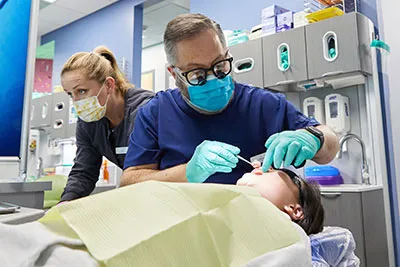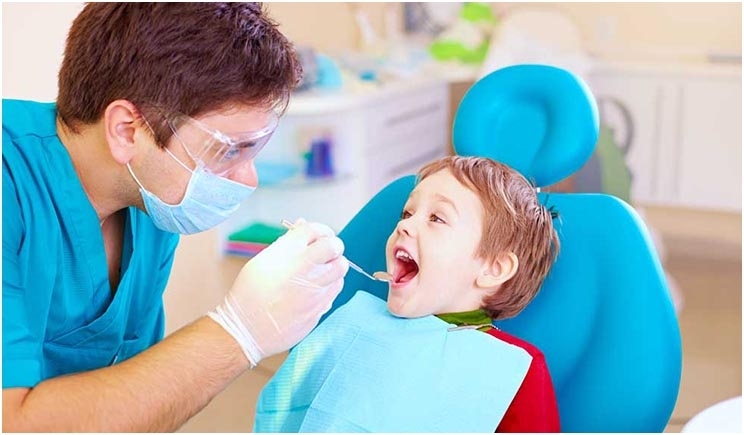Discovering Cutting-edge Therapies: What to Anticipate During Your Following Dental Professional Browse Through
During an oral see, people can prepare for a variety of cutting-edge therapies aimed at improving their total experience. With the introduction of advanced diagnostic tools and sedation alternatives, the focus gets on minimizing pain and anxiousness. On top of that, the shift towards minimally intrusive procedures and electronic technology guarantees improved effectiveness. These advancements question about the future of dental care and what it means for patient end results. What could these developments represent for regular dental gos to?
The Rise of Pain-Free Dentistry

In addition, the assimilation of laser innovation has even more improved the pain-free technique, permitting for accurate treatments that minimize trauma to surrounding cells. Consequently, individuals are more probable to look for routine dental care, adding to far better oral wellness end results. On the whole, the increase of pain-free dental care indicates a substantial evolution in how dental techniques focus on individual comfort and wellness, promoting an extra favorable partnership in between people and their oral wellness service providers.
Advanced Diagnostic Devices
Advancements in pain-free dentistry have actually led the way for improved individual experiences, yet the advancement of oral treatment does not quit there. The combination of advanced diagnostic tools plays a vital function in enhancing dental wellness analyses. Technologies such as digital X-rays, which decrease radiation direct exposure, allow dental experts to acquire high-resolution pictures quickly. This advancement enables more exact medical diagnoses of cavities, bone loss, and other dental problems.
Cone-beam calculated tomography (CBCT) offers three-dimensional imaging, additional refining treatment preparation, especially in intricate cases like orthodontics or implants. In addition, caries discovery tools utilize laser fluorescence to determine decay at its earliest phases, ensuring prompt treatment.
These sophisticated diagnostic tools not just enhance the precision of medical diagnoses but also foster aggressive therapy strategies. As dental treatment remains to progress, these technologies are important for delivering efficient and personalized oral health services, eventually benefiting patients in their oral journeys.
Sedation Options for Anxious Clients

Sorts Of Sedation Available
Exactly how can distressed clients find comfort during dental procedures? Different sedation alternatives are available to assist alleviate their anxieties. Laughing gas, generally recognized as giggling gas, is a preferred option. It supplies a light level of sedation, permitting clients to stay awake while feeling relaxed. Oral sedation involves taking a recommended medicine before the consultation, which helps calm stress and anxiety. For much deeper sedation, intravenous (IV) sedation may be used, delivering medication straight right into the bloodstream for a much more extensive result. General anesthesia is one more option, usually reserved for considerable treatments, rendering the person totally unconscious. Each sedation type has its benefits and factors to consider, enabling dental experts to customize the method to the specific needs of their nervous clients.
Advantages for Nervous Patients
What benefits do sedation alternatives use to nervous individuals undergoing dental treatments? Sedation techniques can significantly decrease anxiety, allowing individuals to experience a calmer, much more unwinded atmosphere. This can lead to better teamwork throughout treatment, causing a smoother dental visit. In addition, sedation can decrease pain, as patients usually feel much less pain or stress throughout treatments. Numerous clients may not bear in mind the treatment, which can help alleviate fear associated with oral gos to. In addition, sedation can be specifically useful for those with a strong trick reflex or trouble sitting still. Overall, these alternatives encourage anxious patients to seek needed dental care without the overwhelming stress and anxiety they could normally experience.
Minimally Invasive Treatments
Minimally invasive treatments represent a significant improvement in oral care, concentrating on maintaining as much of the natural tooth structure as possible. Common methods in this group include laser treatments and air abrasion, which can boost person comfort and decrease recuperation time. Insights from person experiences highlight the efficiency and appeal of these innovative strategies in contemporary dentistry.
Benefits of Minimally Intrusive

Typical Strategies Described
Innovations in oral modern technology have brought about different minimally intrusive treatments that prioritize person comfort and oral wellness. One typical technique is air abrasion, which makes use of a stream of air mixed with great fragments to get rid of degeneration without exploration. An additional is laser dental care, which targets particular areas with precision, reducing damages to surrounding cells. In addition, silver diamine fluoride (SDF) is related to halt tooth cavity development without the requirement for traditional boring. Compound bonding is likewise prevalent, enabling the repair of teeth with natural-looking materials, while preserving as much of the initial tooth framework as possible. These techniques not only minimize healing time but additionally boost the total oral experience by making therapies much less intimidating and a lot more effective.
Client Experience Insights
How do individuals regard their experiences with minimally intrusive oral procedures? Numerous individuals report an increased feeling of comfort and reduced anxiousness when undertaking these therapies. Using innovative modern technologies, such as laser dentistry and air abrasion, permits much less discomfort and quicker healing times. Individuals value that these procedures commonly require less anesthesia and lead to minimal bleeding, which adds to an extra pleasurable browse through. In addition, the focus on protecting additional reading healthy tooth structure resonates with individuals, as it aligns with their need for resilient oral wellness. On the whole, patient responses suggests that minimally invasive techniques not only enhance their dental experience however additionally foster count on their dental treatment companies, advertising a more positive connection with dental wellness.
Digital Impressions and 3D Printing
Welcoming modern technology, numerous dental methods are now utilizing digital impacts and 3D printing to boost client care and enhance procedures. Digital impacts replace standard mold and mildews, capturing precise pictures of an individual's gum tissues and teeth making use of innovative scanning modern technology. This method minimizes discomfort, eliminates the need for messy products, and offers prompt outcomes for both dentists and patients.
All at once, 3D printing is changing the development of oral home appliances, such as crowns, bridges, and aligners. With electronic layouts generated from the perceptions, 3D printers generate personalized solutions promptly and properly. This technology not just accelerates the production process however also ensures a better suitable for the person, resulting in boosted end results.
Enhancements in Aftercare and Follow-Up
The integration of digital perceptions and 3D printing in dental care has paved the means for considerable improvements in client aftercare and follow-up. Improved accuracy in treatment planning enables oral professionals to create customized aftercare methods that attend to private client needs. With the capability to produce custom-fitted appliances and reconstructions rapidly, people experience minimized healing times and improved convenience.
Advancements in telehealth have changed follow-up brows through. Individuals can currently participate in online appointments, making it possible for timely evaluations without the need for in-person consultations - Teeth Whitening. This technique not only conserves time but additionally improves ease of access for those with wheelchair challenges or busy timetables
Furthermore, using mobile applications permits real-time monitoring of recovery development, facilitating instant interaction in between clients and oral groups. These developments collectively lead to more reliable, individualized aftercare, making certain that clients receive complete support throughout their oral trip.
Often Asked Concerns
Just how Frequently Should I See the Dental Practitioner for Exams?
The majority of dental professionals suggest seeing the dentist for check-ups every 6 months. This frequency helps preserve oral wellness, permits very early detection of concerns, and guarantees prompt treatment, advertising general wellness and stopping a lot more major issues.
What Should I Do if I Have Oral Anxiety?
To handle dental stress and anxiety, one ought to connect worry about the dental professional, think about relaxation techniques, bring a supportive pal, schedule appointments throughout quieter times, and check out sedation alternatives to improve convenience during treatments.
Are There Any Kind Of Age Limitations for Sedation Dentistry?
Sedation dentistry commonly has no rigorous age constraints; nonetheless, professionals often evaluate specific wellness problems and specific demands (Teeth Whitening). Pediatric people may need special considerations, while elderly patients might require tailored techniques to guarantee safety and convenience
How Much Time Do Oral Treatments Generally Take?
Oral procedures usually take anywhere from thirty minutes to several hours, depending upon the complexity and kind of treatment. Simple cleansings are quicker, while extensive procedures, like root canals or implants, need even more time and interest.
What Can I Eat After My Dental Appointment?
After an oral consultation, soft foods like yogurt, applesauce, or mashed potatoes are advisable. Individuals must avoid hard, crunchy, or sticky products to guarantee comfort and shield any type of recent therapies or dental job. Hydration is necessary.
Sedation options play a necessary role in giving convenience for people experiencing stress and anxiety during oral visits. What benefits do sedation choices offer to distressed patients going through oral procedures? Lots of people may not remember the treatment, which can help reduce fear linked with oral sees. Improvements in oral modern technology have led to numerous minimally intrusive procedures that prioritize individual convenience and dental health. Just how do patients view their experiences with minimally invasive oral procedures?